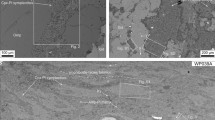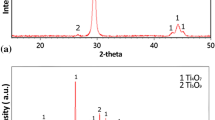Abstract
In an external vacuum and at temperatures between 900° C and 1650° C internal graphitisation takes place on or around mineral inclusions in diamond, and appears to be responsible for similar features previously reported in diamond from several localities. Several mechanisms are proposed and discussed for internal graphitisation at temperatures as low as 900° C: it is proposed that at low external pressures CO2 exsolves from inclusions and causes internal graphitisation. The results also indicate that immediately after pressure release arising from volcanic breakthrough of kimberlites of different geological ages at several localities in West and South Africa, the temperature was not in excess of 800° C to 900° C in certain regions of the diatremes.
Similar content being viewed by others
References
Bardet, M. G., Vachette, M.: Détermination d'âges de kimberlite de l'Ouest Africain, et essai d'interprétation des datations des diverses venues diamondifères dans le monde. Abst. 3rd Symp. of African Geology. Brusselles, Tervuren. (1966).
Dawson, J. B.: The tectonic setting to African kimberlite magmatism. In: African Magmatism and Tectonics, eds. Clifford, T. N., and Gass, I. G., p. 321–336. Edingburgh: Oliver and Boyd 1970.
Dawson, J. B.: The genesis of Kimberlite. Diamond Research. 2–7 (1971).
Evans, T.: Transmission electron microscopy of diamond. In: Physical properties of diamond, ed. Berman, R., p. 116–134. Oxford: Clarendon Press 1965.
Evans, T., Sauter, D. H.: Etching of diamond surfaces by gases. Phil. Mag. 6, 429–440 (1961).
Evans, T., Wild, R. K.: Plastic bending of diamond plates. Phil. Mag. 12, 477–489 (1967).
Frank, F. C., Lang, A. R.: X-ray topography of diamond. In: Physical properties of diamond, ed. Berman, R., p. 69–114. Oxford: Clarendon Press 1965.
Harris, J. W.: The recognition of diamond inclusions. Ind. Diamond Rev. 28, 402–410 (1968).
Harris, J. W.: Black material on mineral inclusions and internal fracture planes in diamond. Contr. Mineral. and Petrol. 35, 22–33 (1972).
Harris, P. G., Middlemost, E. A. K.: The evolution of Kimberlites. Lithos 3, 77–88 (1969).
Howes, V. R.: The graphitisation of diamond. Proc. Phys. Soc. (London) 80, 648–662 (1962).
Junner, N. J.: The diamond deposits of the Gold Coast. Gold Coast Geol. Surv. Bull. No. 12 (1943).
Kennedy, G. C., Nordlie, B. E.: The genesis of diamond deposits. Econ. Geol. 63, 495–503 (1968).
Meyer, H. O. A., Boyd, F. R.: Inclusions in diamond. Carnegie Inst. Yearbook 68, 315–320 (1968).
Phaal, C.: Gas etching of diamond and crystal imperfection. Ph. D. Thesis, Reading (1962).
Roedder, E.: Liquid CO2 inclusions in olivine-bearing nodules and phenocrysts from basalts. Am. Mineralogist 50, 1746–1782 (1965).
Author information
Authors and Affiliations
Rights and permissions
About this article
Cite this article
Harris, J.W., Vance, E.R. Induced graphitisation around crystalline inclusions in diamond. Contr. Mineral. and Petrol. 35, 227–234 (1972). https://doi.org/10.1007/BF00371217
Received:
Issue Date:
DOI: https://doi.org/10.1007/BF00371217




